Input interpretation

NH_3 ammonia + NaBrO_3 sodium bromate ⟶ H_2O water + N_2 nitrogen + NaBr sodium bromide
Balanced equation
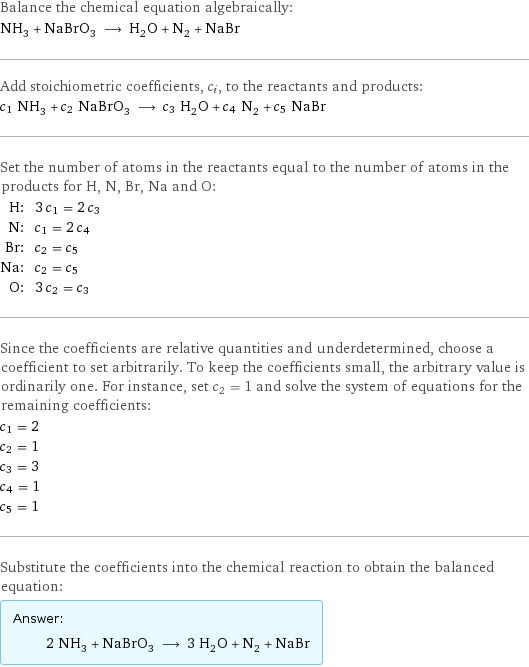
Balance the chemical equation algebraically: NH_3 + NaBrO_3 ⟶ H_2O + N_2 + NaBr Add stoichiometric coefficients, c_i, to the reactants and products: c_1 NH_3 + c_2 NaBrO_3 ⟶ c_3 H_2O + c_4 N_2 + c_5 NaBr Set the number of atoms in the reactants equal to the number of atoms in the products for H, N, Br, Na and O: H: | 3 c_1 = 2 c_3 N: | c_1 = 2 c_4 Br: | c_2 = c_5 Na: | c_2 = c_5 O: | 3 c_2 = c_3 Since the coefficients are relative quantities and underdetermined, choose a coefficient to set arbitrarily. To keep the coefficients small, the arbitrary value is ordinarily one. For instance, set c_2 = 1 and solve the system of equations for the remaining coefficients: c_1 = 2 c_2 = 1 c_3 = 3 c_4 = 1 c_5 = 1 Substitute the coefficients into the chemical reaction to obtain the balanced equation: Answer: | | 2 NH_3 + NaBrO_3 ⟶ 3 H_2O + N_2 + NaBr
Structures

+ ⟶ + +
Names

ammonia + sodium bromate ⟶ water + nitrogen + sodium bromide
Reaction thermodynamics
Enthalpy
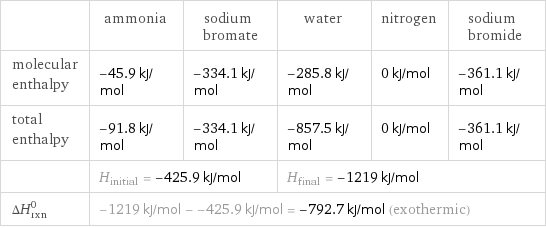
| ammonia | sodium bromate | water | nitrogen | sodium bromide molecular enthalpy | -45.9 kJ/mol | -334.1 kJ/mol | -285.8 kJ/mol | 0 kJ/mol | -361.1 kJ/mol total enthalpy | -91.8 kJ/mol | -334.1 kJ/mol | -857.5 kJ/mol | 0 kJ/mol | -361.1 kJ/mol | H_initial = -425.9 kJ/mol | | H_final = -1219 kJ/mol | | ΔH_rxn^0 | -1219 kJ/mol - -425.9 kJ/mol = -792.7 kJ/mol (exothermic) | | | |
Gibbs free energy
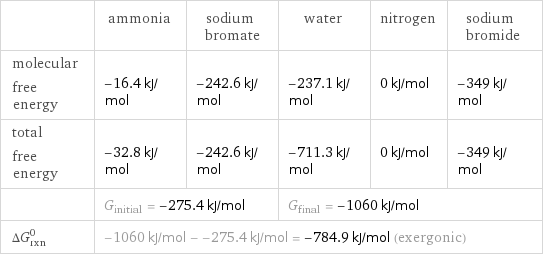
| ammonia | sodium bromate | water | nitrogen | sodium bromide molecular free energy | -16.4 kJ/mol | -242.6 kJ/mol | -237.1 kJ/mol | 0 kJ/mol | -349 kJ/mol total free energy | -32.8 kJ/mol | -242.6 kJ/mol | -711.3 kJ/mol | 0 kJ/mol | -349 kJ/mol | G_initial = -275.4 kJ/mol | | G_final = -1060 kJ/mol | | ΔG_rxn^0 | -1060 kJ/mol - -275.4 kJ/mol = -784.9 kJ/mol (exergonic) | | | |
Equilibrium constant
![Construct the equilibrium constant, K, expression for: NH_3 + NaBrO_3 ⟶ H_2O + N_2 + NaBr Plan: • Balance the chemical equation. • Determine the stoichiometric numbers. • Assemble the activity expression for each chemical species. • Use the activity expressions to build the equilibrium constant expression. Write the balanced chemical equation: 2 NH_3 + NaBrO_3 ⟶ 3 H_2O + N_2 + NaBr Assign stoichiometric numbers, ν_i, using the stoichiometric coefficients, c_i, from the balanced chemical equation in the following manner: ν_i = -c_i for reactants and ν_i = c_i for products: chemical species | c_i | ν_i NH_3 | 2 | -2 NaBrO_3 | 1 | -1 H_2O | 3 | 3 N_2 | 1 | 1 NaBr | 1 | 1 Assemble the activity expressions accounting for the state of matter and ν_i: chemical species | c_i | ν_i | activity expression NH_3 | 2 | -2 | ([NH3])^(-2) NaBrO_3 | 1 | -1 | ([NaBrO3])^(-1) H_2O | 3 | 3 | ([H2O])^3 N_2 | 1 | 1 | [N2] NaBr | 1 | 1 | [NaBr] The equilibrium constant symbol in the concentration basis is: K_c Mulitply the activity expressions to arrive at the K_c expression: Answer: | | K_c = ([NH3])^(-2) ([NaBrO3])^(-1) ([H2O])^3 [N2] [NaBr] = (([H2O])^3 [N2] [NaBr])/(([NH3])^2 [NaBrO3])](../image_source/fd8b9f2594ec7c64ac59c627ab722ac5.png)
Construct the equilibrium constant, K, expression for: NH_3 + NaBrO_3 ⟶ H_2O + N_2 + NaBr Plan: • Balance the chemical equation. • Determine the stoichiometric numbers. • Assemble the activity expression for each chemical species. • Use the activity expressions to build the equilibrium constant expression. Write the balanced chemical equation: 2 NH_3 + NaBrO_3 ⟶ 3 H_2O + N_2 + NaBr Assign stoichiometric numbers, ν_i, using the stoichiometric coefficients, c_i, from the balanced chemical equation in the following manner: ν_i = -c_i for reactants and ν_i = c_i for products: chemical species | c_i | ν_i NH_3 | 2 | -2 NaBrO_3 | 1 | -1 H_2O | 3 | 3 N_2 | 1 | 1 NaBr | 1 | 1 Assemble the activity expressions accounting for the state of matter and ν_i: chemical species | c_i | ν_i | activity expression NH_3 | 2 | -2 | ([NH3])^(-2) NaBrO_3 | 1 | -1 | ([NaBrO3])^(-1) H_2O | 3 | 3 | ([H2O])^3 N_2 | 1 | 1 | [N2] NaBr | 1 | 1 | [NaBr] The equilibrium constant symbol in the concentration basis is: K_c Mulitply the activity expressions to arrive at the K_c expression: Answer: | | K_c = ([NH3])^(-2) ([NaBrO3])^(-1) ([H2O])^3 [N2] [NaBr] = (([H2O])^3 [N2] [NaBr])/(([NH3])^2 [NaBrO3])
Rate of reaction
![Construct the rate of reaction expression for: NH_3 + NaBrO_3 ⟶ H_2O + N_2 + NaBr Plan: • Balance the chemical equation. • Determine the stoichiometric numbers. • Assemble the rate term for each chemical species. • Write the rate of reaction expression. Write the balanced chemical equation: 2 NH_3 + NaBrO_3 ⟶ 3 H_2O + N_2 + NaBr Assign stoichiometric numbers, ν_i, using the stoichiometric coefficients, c_i, from the balanced chemical equation in the following manner: ν_i = -c_i for reactants and ν_i = c_i for products: chemical species | c_i | ν_i NH_3 | 2 | -2 NaBrO_3 | 1 | -1 H_2O | 3 | 3 N_2 | 1 | 1 NaBr | 1 | 1 The rate term for each chemical species, B_i, is 1/ν_i(Δ[B_i])/(Δt) where [B_i] is the amount concentration and t is time: chemical species | c_i | ν_i | rate term NH_3 | 2 | -2 | -1/2 (Δ[NH3])/(Δt) NaBrO_3 | 1 | -1 | -(Δ[NaBrO3])/(Δt) H_2O | 3 | 3 | 1/3 (Δ[H2O])/(Δt) N_2 | 1 | 1 | (Δ[N2])/(Δt) NaBr | 1 | 1 | (Δ[NaBr])/(Δt) (for infinitesimal rate of change, replace Δ with d) Set the rate terms equal to each other to arrive at the rate expression: Answer: | | rate = -1/2 (Δ[NH3])/(Δt) = -(Δ[NaBrO3])/(Δt) = 1/3 (Δ[H2O])/(Δt) = (Δ[N2])/(Δt) = (Δ[NaBr])/(Δt) (assuming constant volume and no accumulation of intermediates or side products)](../image_source/d5eadcafa89b62ffdee699d43bc30cca.png)
Construct the rate of reaction expression for: NH_3 + NaBrO_3 ⟶ H_2O + N_2 + NaBr Plan: • Balance the chemical equation. • Determine the stoichiometric numbers. • Assemble the rate term for each chemical species. • Write the rate of reaction expression. Write the balanced chemical equation: 2 NH_3 + NaBrO_3 ⟶ 3 H_2O + N_2 + NaBr Assign stoichiometric numbers, ν_i, using the stoichiometric coefficients, c_i, from the balanced chemical equation in the following manner: ν_i = -c_i for reactants and ν_i = c_i for products: chemical species | c_i | ν_i NH_3 | 2 | -2 NaBrO_3 | 1 | -1 H_2O | 3 | 3 N_2 | 1 | 1 NaBr | 1 | 1 The rate term for each chemical species, B_i, is 1/ν_i(Δ[B_i])/(Δt) where [B_i] is the amount concentration and t is time: chemical species | c_i | ν_i | rate term NH_3 | 2 | -2 | -1/2 (Δ[NH3])/(Δt) NaBrO_3 | 1 | -1 | -(Δ[NaBrO3])/(Δt) H_2O | 3 | 3 | 1/3 (Δ[H2O])/(Δt) N_2 | 1 | 1 | (Δ[N2])/(Δt) NaBr | 1 | 1 | (Δ[NaBr])/(Δt) (for infinitesimal rate of change, replace Δ with d) Set the rate terms equal to each other to arrive at the rate expression: Answer: | | rate = -1/2 (Δ[NH3])/(Δt) = -(Δ[NaBrO3])/(Δt) = 1/3 (Δ[H2O])/(Δt) = (Δ[N2])/(Δt) = (Δ[NaBr])/(Δt) (assuming constant volume and no accumulation of intermediates or side products)
Chemical names and formulas
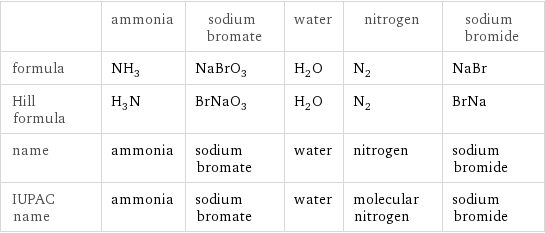
| ammonia | sodium bromate | water | nitrogen | sodium bromide formula | NH_3 | NaBrO_3 | H_2O | N_2 | NaBr Hill formula | H_3N | BrNaO_3 | H_2O | N_2 | BrNa name | ammonia | sodium bromate | water | nitrogen | sodium bromide IUPAC name | ammonia | sodium bromate | water | molecular nitrogen | sodium bromide
Substance properties
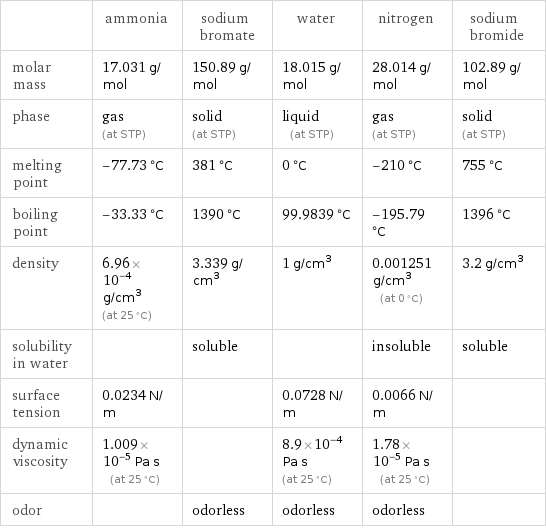
| ammonia | sodium bromate | water | nitrogen | sodium bromide molar mass | 17.031 g/mol | 150.89 g/mol | 18.015 g/mol | 28.014 g/mol | 102.89 g/mol phase | gas (at STP) | solid (at STP) | liquid (at STP) | gas (at STP) | solid (at STP) melting point | -77.73 °C | 381 °C | 0 °C | -210 °C | 755 °C boiling point | -33.33 °C | 1390 °C | 99.9839 °C | -195.79 °C | 1396 °C density | 6.96×10^-4 g/cm^3 (at 25 °C) | 3.339 g/cm^3 | 1 g/cm^3 | 0.001251 g/cm^3 (at 0 °C) | 3.2 g/cm^3 solubility in water | | soluble | | insoluble | soluble surface tension | 0.0234 N/m | | 0.0728 N/m | 0.0066 N/m | dynamic viscosity | 1.009×10^-5 Pa s (at 25 °C) | | 8.9×10^-4 Pa s (at 25 °C) | 1.78×10^-5 Pa s (at 25 °C) | odor | | odorless | odorless | odorless |
Units
